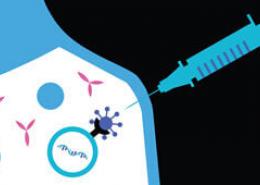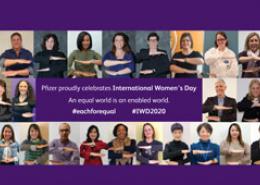MRNA VS. CONVENTIONAL VACCINES

Working Together to Empower Women

Reducing Health Disparities in Latino Communities

Pfizer Women’s Resource Group

Universal vs. Single Payer Healthcare

On March 11, 2020 the World Health Organization declared COVID-19 a pandemic1. Just six days later, on March 17, Pfizer signed a letter of intent with BioNTech to co-develop a potential COVID-19 vaccine2. In those early days, it was unclear how this new virus was transmitted, or how long it would last. But as deaths around the world mounted and life as we knew it drastically changed, one thing became apparent: the virus was spreading rapidly, and the race for a vaccine was underway3.
BioNTech, a German immunotherapy company, had pioneered a new genetic technology that uses a wisp of genetic code from a virus—called messenger RNA—to prompt cells to make antibodies that fight off that virus4. For decades, scientists had been working on similar concepts but frequently met defeat because of issues related to the structure and stability of the mRNA5. By using something called lipid nanoparticles, BioNTech was having success with stabilizing the mRNA6, and by the time COVID-19 struck, the company had already been collaborating with Pfizer to develop a flu vaccine7. Still, to date, no mRNA vaccine had been authorized, nor had such a vaccine ever been manufactured at scale8. Undeterred, the companies poured their resources into stopping COVID-19.
Inside Pfizer, it was dubbed “Project Light Speed,” and its purpose was to make the impossible possible: produce a vaccine by the end of the year9. Over the next nine months, Pfizer and BioNTech would succeed at one of the most ambitious vaccine development program in history, shattering the previous record of four years, set by the development of a mumps vaccine in the 1960s10. The speed and precision was made possible by seamless collaborations, across companies and across countries, working together to scale up manufacturing and meet the unheard-of goal of producing billions of vaccine doses. It’s taken dedication, sacrifice, cooperation, and endless hours spent on video calls.
In the three-part series that follows, we’ll examine the steps that Pfizer teams around the globe are taking to meet the goal of manufacturing 3 billion doses of the vaccine by the end of 2021in an effort to help stop the pandemic.
Building up Pfizer’s existing manufacturing facilities
In the first part of the series, we’ll look at two critical manufacturing facilities that were responsible for designing a process to produce, at industrial scale, a vaccine that didn’t yet exist. As research and development teams focused on testing different vaccine candidates, two of Pfizer’s largest plants — located in Kalamazoo, Michigan and Puurs, Belgium — set aside space and, together, engineered a process to safely manufacture the vaccine. Luc Van Steenwinkel, who is Vice President of Pfizer Puurs, knew the odds were stacked against them. Still, he was energized by the project, and he knew there was no time to waste.
“Developing a new medicine or vaccine, if you look at the traditional success ratios, you have more of a chance to fail than succeed,” he says. “But this vaccine was very different. Given the gravity of the situation we found ourselves in—a global pandemic with cases rising by the day— we knew from the beginning that we had to throw everything at this to be successful. At that time we knew little about the actual construct, the dosage, and how an industrial manufacturing process would look. Nevertheless, we managed to build a completely new formulation suite ready for startup in 100 days! In parallel, we did all the tests for the scaling up of the process of making LNPs from lab scale to industrial scale.”
Patrick McEvoy, who is a Kalamazoo-based Senior Director of Operations and Engineering with Pfizer, remembers the early days, when it was important to keep hope alive with his team and focus on the end goal. “I said, ‘I don’t want to hear the 1,000 ways this can fail. We just need one way that it could be successful and we will rally around that and make it better,’” he recalls. “We knew people were dying every day, and our leadership reminded us of that every day. Time was not on our side, and our mission was critical. Every day mattered and every patient mattered, and we knew we needed to focus on that. That never wavered.”
In Zaventem, Belgium, not far from Puurs, Danny Hendrikse was thinking about shipping and systems. As Vice President Intercompany Operations of Pfizer Global Supply, they knew that it would be their job to get the vaccines from the plants to the point of vaccination. Keeping it extremely cold would be imperative and, for quality and security purposes, they wanted to find a way to monitor and track it in real time. So he and his team started quickly designing a never-before-seen shipper box that would allow for all of the above. “We were designing, building and flying the plane at the same time,” says Hendrikse.
Bringing on contractors to help with production
Even as teams at Puurs and Kalamazoo worked around the clock, their facilities alone would likely not be enough to produce the doses needed in the designated time frame, should the vaccine prove to be effective. As COVID-19 deaths continued to rise—especially in low- and middle-income countries—there was a clear demand to vaccinate more people as quickly as possible. The second part of this series delves into the ways that Pfizer works with outside organizations, called contract manufacturing organizations (CMOs), to manufacture the vaccine.
Finding the right sites fell to Amy Genest, who is a New Products Lead, external supply with Pfizer Global Supply and works to scout viable CMOs for different Pfizer medicines. She describes those early conversations as “awkward” because there were so many unknowns. “In June and July of 2020, we were starting to get into some negotiations. And at that point, we didn’t even have any clinical data to know if we had a valid product,” says Genest. It wouldn’t be until November 2020, when clinical trial data was released, that the vaccine’s efficacy would be known. To make matters more challenging, Genest and her team weren’t able to travel because of the pandemic, so they relied on video calls and virtual tours. After dozens of conversations, they found more than 15 CMOs that were ready, willing, and able to help, if needed.
Those CMOS, in turn, began communicating with Poonam Mulherkar and her team. As a Director of External Supply Technology with Pfizer Global Supply, Mulherkar works with partner organizations to conduct what’s called a “tech transfer.” The Pfizer tech transfer team partners with the selected CMO to transfer technology and experience from the internal site to help them deliver a comparable product to one made at a Pfizer facility.
In Mulherkar’s 10 years working at Pfizer, she’d not encountered a project with so much uncertainty. She was advising on processes for a vaccine that still had more questions than answers. It demanded flexible and understanding CMO partners. “The processes were not set in stone to where you can just hand off a package and say, ‘You’ll run this,’” Mulherkar recalls. “We needed someone who could work with us while the process was being developed. All of this made it challenging,” she says. Add to that a timeline at least twice as fast as the norm.
Making the raw materials
And then there’s the hard work and planning that was required to ensure a consistent and robust supply of the raw materials needed to develop the vaccine at such scale—a vaccine which includes 280 separate components. In the third and final part of this series, we’ll explore a solution the organization devised when it encountered challenges in accessing certain raw materials—namely, a key lipid critical in manufacturing the vaccine. Rather than gamble on sourcing this lipid, Pfizer’s R&D team designed a process to manufacture it, and the Kalamazoo plant adopted the method at an industrial scale.
Starting in late December of 2020, as Pfizer was racing to meet its manufacturing goals and distribute the vaccine far and wide, a team led by Melissa French, who is a Project Manager with Pfizer Global Supply, embarked on a fast-tracked project to create this vital raw materials. “Having an internal lever to pull for supply assurance as they were ramping up became very important,” she says. “It would have been very challenging to rely solely on external suppliers.”
Throughout this series, you’ll also read about the ways that professional and personal lives intersected. The Pfizer teams working to create a vaccine to stop COVID-19 were, of course, operating in the shadow of the pandemic, which added cumulative stresses for parents with children learning remotely, and presented new worries for others regarding their own aging parents. And while the individuals’ stories all differed, one common thread came through loud and clear: the pandemic presented the most challenging time of people’s lives, but also the most rewarding, as they put their energies and expertise toward a shared effort to help the world.
“We didn’t know how this was going to end,” says McEvoy. “We’ve asked amazing, impossible things of our folks. And in every place we discovered a challenge, we worked together to overcome it.”
Read on to learn about what this monumental manufacturing effort looked like to those who lived it.
Read more from the Shot of a Lifetime series:
- Shot of a Lifetime: How Two Pfizer Manufacturing Plants Upscaled to Produce the COVID-19 Vaccine in Record Time
- Shot of a Lifetime: How Pfizer is Partnering with CMOs to Increase COVID-19 Vaccine Production and Reach More People
- Shot of a Lifetime: How Pfizer Developed its Own Raw Materials to Ensure a Steady Supply for the COVID-19 Vaccine
1. WHO. WHO Director-General’s Opening Remarks at the Media Briefing on COVID-19 11 March. Available at https://www.who.int/director-general/speeches/detail/who-director-general-s-opening-remarks-at-the-media-briefing-on-covid-19—11-march-2020. Accessed 9/30/21.
2. Pfizer. Pfizer and BioNTech to Co-Develop Potential COVID-19 Vaccine. Available at https://investors.pfizer.com/investor-news/press-release-details/2020/Pfizer-and-BioNTech-to-Co-Develop-Potential-COVID-19-Vaccine/default.aspx. Accessed 9/30/21.
3. AP News. US Begins ‘Warp Speed’ Vaccine Push as Studies Ramp Up. Available at https://apnews.com/article/virus-outbreak-donald-trump-us-news-international-news-politics-756e5b743058701c4a2ebefd0af1ade4. Accessed 9/30/21.
4. Financial Times. Inside the Hunt for a Covid-19 Vaccine: How BioNTech Made the Breakthrough. Available at https://www.ft.com/content/c4ca8496-a215-44b1-a7eb-f88568fc9de9. Accessed 9/30/21.
5. Nature. The Tangled History of mRNA Vaccines. Available at https://www.nature.com/articles/d41586-021-02483-w. Accessed 9/30/21.
6. Nature. Let’s Talk about Nanoparticles. Available at https://www.nature.com/articles/s41578-021-00281-4. Accessed 9/30/21.
7. Businesswire. BioNTech Signs Collaboration Agreement with Pfizer to Develop mRNA-based Vaccines for Prevention of Influenza. Available at https://www.businesswire.com/news/home/20180815005735/en/BioNTech-Signs-Collaboration-Agreement-with-Pfizer-to-Develop-mRNA-based-Vaccines-for-Prevention-of-Influenza. Accessed 9/30/21.
8.The Scientist. The Promise of mRNA Vaccines. Available at https://www.the-scientist.com/news-opinion/the-promise-of-mrna-vaccines-68202. Accessed 9/30/21.
9. Pfizer. Pfizer and BioNTech Announce Further Details on Collaboration to Accelerate Global Covid-19 Vaccine Development. Available at https://www.pfizer.com/news/press-release/press-release-detail/pfizer-and-biontech-announce-further-details-collaboration. Accessed 9/30/21.
10. History.com. How a New Vaccine was Developed in Record Time in the 1960s. Available at https://www.history.com/news/mumps-vaccine-world-war-ii. Accessed 9/30/21.
Source: Read Full Article